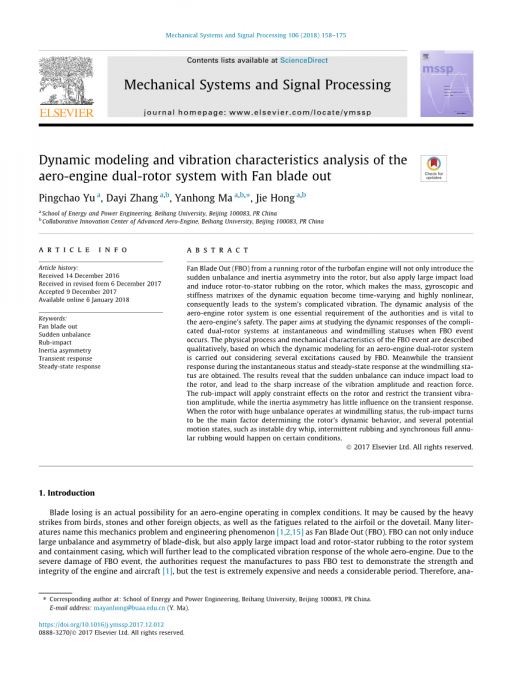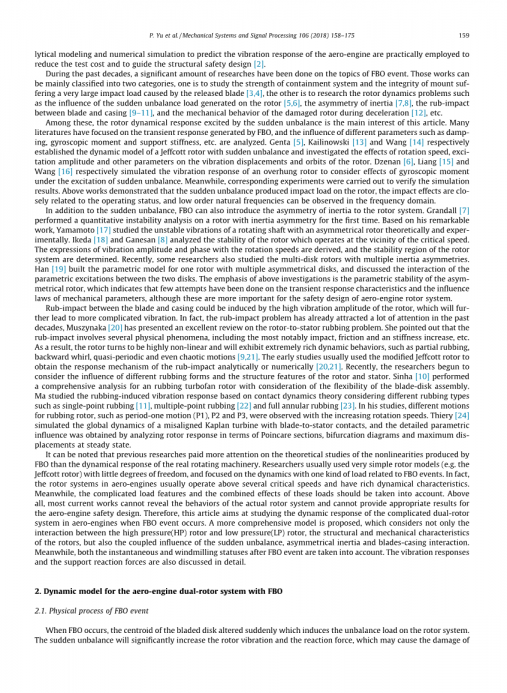

英语原文共 18 页
Dynamic modeling and vibration characteristics analysis of the aero-engine dual-rotor system with Fan blade out
Pingchao Yua, Dayi Zhanga,b,Yanhong Ma a,b, Jie Hong a,b
aSchool of Energy and Power Engineering, Beihang University, Beijing 100083, PR China
bCollaborative Innovation Center of Advanced Aero-Engine, Beihang University, Beijing 100083, PR China
Abstract. Fan Blade Out (FBO) from a running rotor of the turbofan engine will not only introduce the sudden unbalance and inertia asymmetry into the rotor, but also apply large impact load and induce rotor-to-stator rubbing on the rotor, which makes the mass, gyroscopic and stiffness matrixes of the dynamic equation become time-varying and highly nonlinear, consequently leads to the systemrsquo;s complicated vibration. The dynamic analysis of the aero-engine rotor system is one essential requirement of the authorities and is vital to the aero-enginersquo;s safety. The paper aims at studying the dynamic responses of the complicated dual-rotor systems at instantaneous and windmilling statuses when FBO event occurs. The physical process and mechanical characteristics of the FBO event are described qualitatively, based on which the dynamic modeling for an aero-engine dual-rotor system is carried out considering several excitations caused by FBO. Meanwhile the transient response during the instantaneous status and steady-state response at the windmilling status are obtained. The results reveal that the sudden unbalance can induce impact load to the rotor, and lead to the sharp increase of the vibration amplitude and reaction force.The rub-impact will apply constraint effects on the rotor and restrict the transient vibration amplitude, while the inertia asymmetry has little influence on the transient response.When the rotor with huge unbalance operates at windmilling status, the rub-impact turns to be the main factor determining the rotorrsquo;s dynamic behavior, and several potential motion states, such as instable dry whip, intermittent rubbing and synchronous full annular rubbing would happen on certain conditions.
Keywords:Fan blade out,Sudden unbalance, Rub-impact, Inertia asymmetry, Transient response, Steady-state response
1. Introduction
Blade losing is an actual possibility for an aero-engine operating in complex conditions. It may be caused by the heavystrikes from birds, stones and other foreign objects, as well as the fatigues related to the airfoil or the dovetail. Many literatures name this mechanics problem and engineering phenomenon [1,2,15] as Fan Blade Out (FBO). FBO can not only induce large unbalance and asymmetry of blade-disk, but also apply large impact load and rotor-stator rubbing to the rotor system and containment casing, which will further lead to the complicated vibration response of the whole aero-engine. Due to the severe damage of FBO event, the authorities request the manufactures to pass FBO test to demonstrate the strength and integrity of the engine and aircraft [1], but the test is extremely expensive and needs a considerable period. Therefore, analytical modeling and numerical simulation to predict the vibration response of the aero-engine are practically employed to reduce the test cost and to guide the structural safety design [2].
During the past decades, a significant amount of researches have been done on the topics of FBO event. Those works can be mainly classified into two categories, one is to study the strength of containment system and the integrity of mount suffering a very large impact load caused by the released blade [3,4], the other is to research the rotor dynamics problems such as the influence of the sudden unbalance load generated on the rotor [5,6], the asymmetry of inertia [7,8], the rub-impact between blade and casing [9–11], and the mechanical behavior of the damaged rotor during deceleration [12], etc.
Among these, the rotor dynamical response excited by the sudden unbalance is the main interest of this article. Many literatures have focused on the transient response generated by FBO, and the influence of different parameters such as damping, gyroscopic moment and support stiffness, etc. are analyzed. Genta [5], Kailinowski [13] and Wang [14] respectively established the dynamic model of a Jeffcott rotor with sudden unbalance and investigated the effects of rotation speed, excitation amplitude and other parameters on the vibration displacements and orbits of the rotor. Dzenan [6], Liang [15] and Wang [16] respectively simulated the vibration response of an overhung rotor to consider effects of gyroscopic moment under the excitation of sudden unbalance. Meanwhile, corresponding experiments were carried out to verify the simulation results. Above works demonstrated that the sudden unbalance produced impact load on the rotor, the impact effects are closely related to the operating status, and low order natural frequencies can be observed in the frequency domain.
In addition to the sudden unbalance, FBO can also introduce the asymmetry of inertia to the rotor system. Grandall [7] performed a quantitative instability analysis on a rotor with inertia asymmetry for the first time. Based on his remarkable work, Yamamoto [17] studied the unstable vibrations of a rotating shaft with an asymmetrical rotor theoretically and experimentally. Ikeda [18] and Ganesan [8] analyzed the stability of the rotor which operates at the vicinity of the critical speed. The expressions of vibration amplitude and phase with the rotation speeds are derived, and the stability region of the rotor system are determined. Recently, some researchers also studied the multi-disk rotors with multiple inertia asymmetries. Han [19] built the parametric model for one rotor with multiple asymmetrical disks, and discussed the i
以上是毕业论文外文翻译,课题毕业论文、任务书、文献综述、开题报告、程序设计、图纸设计等资料可联系客服协助查找。


